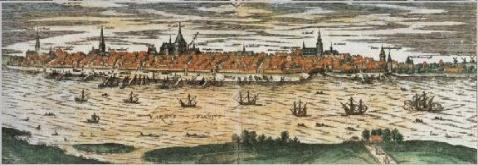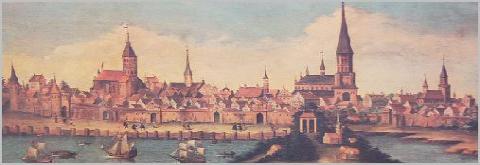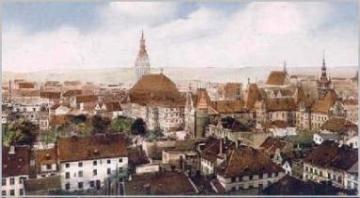
The Duchy of Pomerania existed from the 12th century until mid 17th century. From the late 12th century, the Griffin Duchy of Pomerania stayed with the Holy Roman Empire and the Principality of Rugia (Rügen) with Denmark, while Denmark, Brandenburg, Poland and the Teutonic Knights struggled for control in Samboride Pomerelia. The Teutonic Knights absorbed Pomerelia in the early 14th century.
Pomerania became a predominantly German area, while the Slavic Pomeranians, or “Kashubians,” continued to settle in the rural East. In 1325, the Griffins inherited the principality of Rugia and Pomerelia became subject to the Polish Crown in 1466 as a part of Royal Prussia with the defeat of the Teutonic Order. In 1534, the Duchy of Pomerania adopted the Protestant reformation while the Kashubians of Pomerelia remained Catholic. The Thirty Years’ War was brutal in most of Pomerania and the house of Griffin was extinguished. The Duchy of Pomerania was divided between Sweden and Brandenburg-Prussia in 1648.
Prussia gained the southern parts of Swedish Pomerania in 1720, Pomerelia in 1772, and the remainder of Swedish Pomerania in 1815. The former Duchy of Pomerania was reorganized into the Prussian Province of Pomerania, while Pomerelia was transformed into the Province of West Prussia. With Prussia, both provinces joined the newly constituted German Empire in 1871.
Except for the eastern-most districts, which were in ancient times partly Polish and where a small Polish-speaking minority remained, Pomerania was German for almost all of modern history. The historical capital of the Prussian province of Pomerania, which stretched almost to Danzig, was the stately and intellectual city of Stettin. Until 1637, Stettin, a fortress as early as the 12th century, was the residence of the dukes of Pomerania and an important member of the Hanseatic League. At the Peace of Westphalia in 1648, it passed to Sweden, but was ceded to Prussia in 1720.

|
| Rostock, 1587 |

|
| Greifswald 1532 |

|
| Anklam 16th century |

|
| Danzig |

|
| Elbing |

|
| Stetten |
Greifswald, home of artist Caspar David Friedrich, is located near the Bay of Greifswald, part of the Baltic Sea between the islands of Rügen and Usedom. It was settled primarily by Germans and became a well-known market for the salt trade. When the Danes surrendered the Pomeranian lands south of the Ryck in 1227, the town became of great interest to the Pomeranian dukes, who with the Rugian prince, granted Greifswald market rights in 1241. Greifswald became one of the earliest members of the Hanseatic League at the end of the 13th century, which further increased its prosperity. In 1456, the foundations were laid for another of the oldest universities in the world, the University of Greifswald. After the Thirty Years’ War, which had disasterous effects on the town, Greifswald became part of the Kingdom of Sweden in 1631 and remained in Swedish Pomerania until 1815, when it became part of the Prussian Province of Pomerania.
The town of Swinemünde was on the island of Usedom. The river Swina ran to the Prussian Baltic coast between two small fishing villages, East and West Swina, and when the river was dredged and widened for larger ships at the beginning of the 17th century, Swinemünde was founded on the site of old West Swina. Friedrich the Great granted the town its privileges in 1765, and it served as the outer port of Stettin. The quaint town, with its “Dutch” style houses, grew up with a fishing and shipping industry, and its fortified entrance to the harbor was protected by two long breakwaters with the lighthouse on tiny Wolin Island protecting sailors of old. In 1897, the Kaiserfahrt canal was opened, with the waterway deepened between the Stettin harbor and the Baltic, and Swinemünde no longer had much strategic importance and it became a tourist resort town.
Kolberg, another small city in Pomerania, was on the right bank of the Persante, which flows to the Baltic. A statue of Friedrich Wilhelm III graced its marketplace and many of its buildings dated from the 14th century. German Kolberg was one of the oldest places of Pomerania, having been granted city rights in 1255. In 1284, it became a member of the Hanseatic League. The Swedes captured the town in 1631 during the Thirty Years’ War, then it passed by the treaty of Westphalia to Friedrich Wilhelm I, elector of Brandenburg, who fortified it. During the Seven Years War, it was a center of activity, and in 1758 and 1760, the Russians laid siege to it, finally capturing it in 1762. Eventually restored to Brandenburg, it was attacked by the French in 1806 and 1807, but was saved by the long resistance of its inhabitants under the heroism of Joachirn Christian Nettelbeck, 1738-1824. It then faded in its glory, but it became a fashionable resort area.
Anklam obtained German town status in 1244, and in 1283 became a member of the Hanseatic League. Although the town was a rather small, the association brought wealth and prosperity wealth to Anklam. Swedish and Imperial troops battled here for almost twenty years for Anklam during the Thirty Years’ War, after which the town became a part of Swedish Pomerania until 1676. In 1713, it was plundered by the Russian Empire. The southern parts of the town, were ceded to the Kingdom of Prussia in 1720, while the smaller part north of the Peene River remained Swedish. Anklam was a divided town until 1815, when all of Western Pomerania became Prussian.
Stralsund, a medieval city by the sea, was founded in 1234 by settlers from Rügen, and grew with the arrival of Germans a short time later. After an attack by shipping rival Lübeck in 1249, the town was rebuilt with a massive city walls, gates and watch towers. Stralsund became a member of the Hansa, and 300 of her ships sailed the Baltic by the 14th century. At the Treaty of Westphalia, she was handed to Sweden. In 1815,Stralsund went from Swedish control to Prussian.
It received German city rights in 1343, but the oldest town seal dates from the 13th century and indicates that the town may have received city rights even before 1308.It became one of the four major towns of the Hanseatic League. With increasing passage through the Sound separating Sweden and Denmark in the late 14th century, Scottish trade with the eastern Baltic, especially Königsberg and Danzig, grew rapidly. Evidence proves that timbers in Scottish buildings originated from this area at this time. In 1455, Danzig shed the Teutonic Order and was formally ceded to the Polish king along with the whole of West Prussia at the peace of Thorn. However, it was still allowed free city rights, and it governed a large territory of over thirty villages.
There were 3150 master craftsmen in Danzig of a population of some 50,000 by the turn of the 16th century, almost all of whom were German, and old shipping records demonstrate that by then a wide variety of goods were being traded with Danzig. It was in then that the settlement of New Scotland appeared in Danzig, with many Scottish emigrants in the Danzig Bürgerbuch.
Danzig was an autonomous city during most of the 16th century and, as the power of the Hansa as well as of various Teutonic orders waned, Danzig still prospered, mostly from its massive grain trade. With the counter-reformation, King Sigismund of Poland tried to reduce the power of the protestant city council by imposing the Statuta Karnkowiana upon the city, but it was largely ignored until Stephan Bathory succeeded Sigismund. Danzig’s City Council refused to pay homage to the Polish throne until the city’s old autonomy was recognised, and Bathory laid siege to the city in 1577. The siege was strongly resisted and, in a negotiated settlement, the city paid 200,000 Gulden to the Polish crown so that the autonomy of the city was allowed to continue.
It suffered severely through various wars of the 17th and 18th centuries. At the first partition of Poland in 1772, Danzig was separated from Poland again and in 1793 it came into the possession of Prussia who repaired, improved and heavily invested in the city. In 1807, during the French and Prussian War, it was bombarded and captured by the French, and Marshal Lefebvre took the ostentatious title of “Duke of Danzig.”
At Tilsit, Napoleon restored it to its ancient territory and declared it a free town, but under the protection of France, Prussia and Saxony. With a corrupt French governor in place, Danzig’s trade was soon ruined. It was given back to Prussia in 1814, and Prussia once again repaired, improved and invested even more into the city. It finally became part of the German Empire.
During the Middle Ages, the Old Prussian settlement of Truso was located near the site of German Elbing. Elbing, thirty five miles east of Danzig, was founded by German tradesmen in the 13th century, and the Teutonic Knights who conquered the region and populated it with more Germans. After the defeat of the Teutonic Knights, the city successively passed under the control of Poland, Prussia, and Germany.
With a history similar to Danzig, Elbing was built with German architecture, money and work, enjoyed a fully German-speaking community, and had a German majority for more than 700 years.